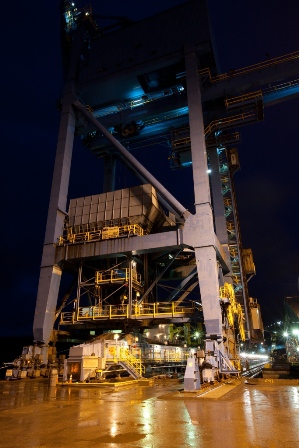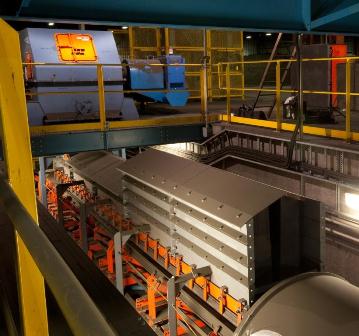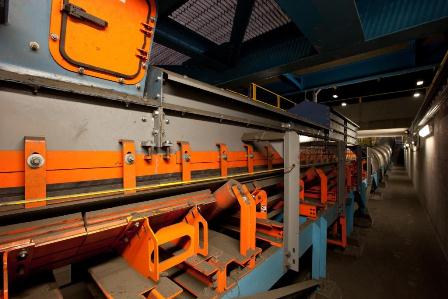Conveyor System Upgrades at Kinder Morgan Vancouver Wharves Facility
Publicado: October 30th 2012
 [North Vancouver, BC] – The largest independent terminal operator in North America has announced completion of a load-out hopper and four belt conveyors capable of carrying as much as 1,500 metric tons per hour of mineral ore concentrate, complete with five transfer points that comply with the company’s “zero spill” principle. The entire system of chutes and transfers at Kinder Morgan’s North Vancouver, BC facility was designed by Martin Engineering, custom-engineered and modeled in 3-D.
[North Vancouver, BC] – The largest independent terminal operator in North America has announced completion of a load-out hopper and four belt conveyors capable of carrying as much as 1,500 metric tons per hour of mineral ore concentrate, complete with five transfer points that comply with the company’s “zero spill” principle. The entire system of chutes and transfers at Kinder Morgan’s North Vancouver, BC facility was designed by Martin Engineering, custom-engineered and modeled in 3-D.
The Martin Transfer Chutes confine the material stream and reduce air entrainment, while directing the moving material onto the receiving belt with minimal impact to reduce spillage, abrasion, dust and premature wear. This control also helps ensure that material is center-loaded on the belt, avoiding mis-tracking and fugitive dust. The new transfer points provide the dual benefits of minimizing aeration and preventing buildup within the chute, which is particularly important when dealing with combustible materials.
Four of the new transfer points employ a “hood and spoon” transfer, with the hood discharge chute at the top of the system and a spoon receiving chute to place material onto the belt being loaded. These engineered flow chutes employ special geometries that capture and concentrate the material stream as it travels through the chute. The fifth transfer point required a heavy-duty impact area at the bottom of a hopper to handle cargo from two front loaders.
Environmental Stewardship and Safety are among Kinder Morgan’s core principles, and all the minerals concentrate storage and handling facilities at the terminal are fully enclosed to ensure that no fugitive material escapes into the environment. From the outset, company officials knew that particular attention would be needed on the five conveyor transfers in order to prevent the escape of dust.
“When we spent some time reviewing the existing transfer points, it became apparent that there was now better technology available, and we wanted equipment that could elevate the performance and containment to a new level,” said K-M Engineering & Project Development Manager Al Price-Stephens.  During initial meetings, the Martin Engineering team introduced a variety of new technologies to improve efficiency and dust containment. “They helped us reach a good understanding of what’s available, and we found additional details on the company’s web site,” Price-Stephens continued. “We also became very familiar with the Martin Engineering book, Foundations IV, which has become the bible of bulk materials handling.”
During initial meetings, the Martin Engineering team introduced a variety of new technologies to improve efficiency and dust containment. “They helped us reach a good understanding of what’s available, and we found additional details on the company’s web site,” Price-Stephens continued. “We also became very familiar with the Martin Engineering book, Foundations IV, which has become the bible of bulk materials handling.”
To address the site’s specific requirements and design the optimum containment, Martin Engineering conducted a site survey, followed by a conveyor risk assessment. The strategy that emerged gave Martin Engineering responsibility for the design and fabrication of the five transfers, as well as supervising the installation by an outside contractor.
“Load zones and discharge points are prime sources for the creation and release of airborne dust,” explained Martin Engineering Global Projects Manager Greg Bierie. “The amount of dust created in a transfer point depends on a number of factors, including the nature of the material and the height of the drop onto the belt, as well as the speed and angle of the loading and unloading belts,” he said.
The project was kicked off with material testing at Martin Engineering’s Center for Innovation at the company’s headquarters in Neponset, IL. “By testing the customer’s specific bulk material and applying those properties as the initial step in chute design, we can develop a transfer that maximizes capacity, while minimizing the potential for build-up and fugitive material,” Bierie said.  Weekly meetings were held from the beginning of the project through final design, which allowed all participants to see and discuss the status of each transfer point as it was being designed. “Every chute design is tailored to suit the specific material characteristics and conveyor systems of the individual customer, rather than using stock products and attempting to make them work,” observed Martin Engineering Projects Manager Tim Patrick O’Harran.
Weekly meetings were held from the beginning of the project through final design, which allowed all participants to see and discuss the status of each transfer point as it was being designed. “Every chute design is tailored to suit the specific material characteristics and conveyor systems of the individual customer, rather than using stock products and attempting to make them work,” observed Martin Engineering Projects Manager Tim Patrick O’Harran.
“Martin engineering works with a 3D model, which not all designers do,” Price-Stephens said. “It’s much easier to look at a 3D model and resolve some of the potential issues before fabrication.”
The new conveyors range from 105 feet (~32 meters) to 709 feet (216 meters) in length, and either 42" (106.68 cm) or 48" (122 cm) wide. Average speeds range from 177 feet per minute (0.9 meters per second) on the shortest run to 565 FPM (2.87 MPS) on the longest conveyor. Liner materials were installed on all five transfer chutes to resist abrasion and extend service life.
Asked to summarize the experience overall, Price-Stephens said, “We were pleased by the level of support that we received from Martin Engineering, without having to hound anyone. And we were impressed by the fact that when we did the initial start-up, it was the guys who helped design the equipment who were there to oversee the start-up.
“To some extent, I think bulk terminals like ours have learned to live with a certain amount of spillage and dust, believing that it’s unavoidable,” he added. “We’ve proven here that isn’t the case. When you look at the components and see what’s been designed for this facility, you realize the concepts and technology are pretty straightforward. It’s really about simple things done well.”
Kinder Morgan is the largest independent terminal operator in North America, with 180 locations. The Vancouver Wharves terminal in North Vancouver, BC delivers inbound and outbound services to shippers moving cargo between all regions of western Canada, handling mineral concentrates, liquids (diesel and jet fuel), sulfur and specialty agricultural products. The terminal handles more than 600,000 metric tons of mineral concentrate per year across five different storage buildings.